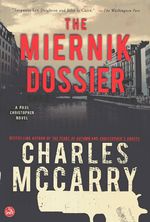The Miernik Dossier: Difference between revisions
imported>Hayford Peirce (→Critical appraisal: filled in the ref. info) |
imported>Hayford Peirce (added a little more) |
||
| Line 18: | Line 18: | ||
[[Eric Ambler|Ambler]], of course, was the most wildly known spy novelist of an earlier generation. | [[Eric Ambler|Ambler]], of course, was the most wildly known spy novelist of an earlier generation. | ||
==Narrative structure== | |||
The story is told, as many others had been done earlier (''[[Lament for a Maker]]'', for instance, by [[Michael Innis]]}, from the viewpoints of many of the characters, as well as from outside observers. | |||
==Plot== | |||
==Notes== | ==Notes== | ||
<references/> | <references/> | ||
Revision as of 14:13, 7 April 2013
The Miernik Dossier, published by the Saturday Review Press in 1973, was the first of sevens novels by the American novelist Charles McCarry featuring an American intelligence agent named Paul Christopher. Set in 1959 in Europe and Africa during the days of the Cold War, it is narrated in the form of reports, overheard conversations, and various documents from a multitude of sources of different nationalities, supposedly giving the reader an authentic picture of what an actual intelligence operation might be like. McCarry had previously been an undercover operative for the Central Intelligence Agency for nine years, and the book was hailed for its apparent authenticity and realistic depiction of tradecraft. It received excellent reviews, and instantly established McCarry's reputation as one of the foremost American novelists of espionage.
Critical appraisal
At the time of its publication, Newgate Callendar, the weekly mystery reviewer of the New York Times, called it "a fast-moving tale of Byzantine intrigue" and said that Miernik himself was "continuously interesting".[1]
Then, 15 years later, reviewing a non-Christopher novel by McCarry in the Times, John Gross wrote in 1988:
Charles McCarry's first novel, The Miernik Dossier, which was published in 1973, is arguably the finest modern American spy story, the only one that matches the leading British masters of the genre in subtlety and ingenuity. It featured an agent called Paul Christopher, and Christopher's adventures form the basis of four subsequent novels by Mr. McCarry, none quite as good as The Miernik Dossier, but all far superior to the average cloak-and-dagger concoction.[2]
Writing in the Wall Street Journal in 2009, the noted contemporary thriller writer Alan Furst called it number two of the five best spy novels ever written:
It is a travelogue that bristles with suspicion and deception—but don’t listen to me, listen to a certain highly acclaimed spy novelist who reviewed McCarry’s literary debut: "The level of reality it achieves is high indeed; it is superbly constructed, wholly convincing, and displays insights that are distinctly refreshing. A new and very welcome talent." Good call, Eric Ambler.[3]
Ambler, of course, was the most wildly known spy novelist of an earlier generation.
Narrative structure
The story is told, as many others had been done earlier (Lament for a Maker, for instance, by Michael Innis}, from the viewpoints of many of the characters, as well as from outside observers.
Plot
Notes
- ↑ "Criminals at Large," by Newgate Callendar, The New York Times, July 8, 1973
- ↑ "Books of the Times; A Romantic Tale of the New World," by John Gross, The New York Times, August 23, 1988, at [1]
- ↑ "Books: Five Best: These five are unsurpassed says novelist Alan Furst," by Alan Furst, The Wall Street Journal, June 13, 2009, at [2]
